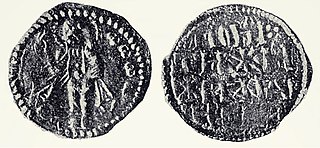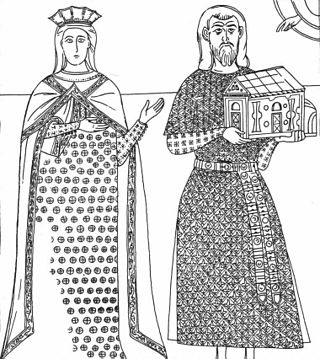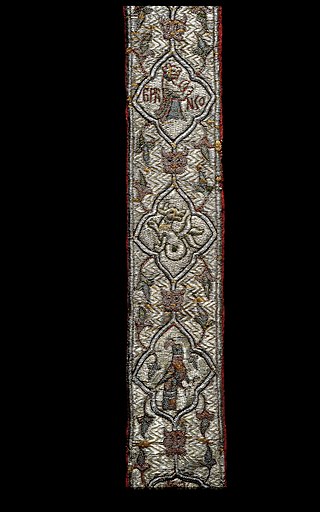Related Research Articles

Dejan was a magnate who served Serbian Emperor Stefan Dušan as sevastokrator, and Emperor Uroš V as despot. He was married to Emperor Dušan's sister Teodora, and possessed a large province in the Kumanovo region, east of Skopska Crna Gora. It initially included the old župe (counties) of Žegligovo and Preševo. Uroš V later gave Dejan the Upper Struma river with Velbužd (Kyustendil). Dejan rebuilt the Zemen Monastery, one of Dejan's endowments, among others, as he also reconstructed several church buildings throughout his province.

Đuraš Ilijić was a nobleman who served the Serbian monarchs Stefan Dečanski, Stefan Dušan and Uroš V, from 1326 until his death in 1362. He had the title of čelnik ("head"), and governed Upper Zeta. He is an ancestor of the Crnojević noble family.

Andrea Gropa was a 14th-century Albanian nobleman who ruled the region and the city of Ohrid, first as a minor vassal for a very short time (župan) to Serbian King Vukašin Mrnjavčević, then as independent after 1370. He was a rival to Prince Marko and together with Andrea II Muzaka managed to take Prilep and Kostur from him. He hailed from the noble Gropa family.
In the medieval Serbian states, the privileged class consisted of nobility and clergy, distinguished from commoners, part of the feudal society. The Serbian nobility were roughly grouped into magnates, the upper stratum, and the lesser nobility (vlasteličići). Serbia followed the government model established by the Byzantine Empire.

Dragoslav or Jovan Dragoslav was a Serbian nobleman with the titles of kaznac, and then veliki kaznac, serving King Stefan Milutin. The kaznac was a financial-taxation office, translated into Latin camerarius (chamberlain). In the hierarchy of the Serbian court, kaznac ranked higher than stavilac and čelnik, and lower than tepčija and vojvoda, the supreme title. He was part of the generation of Serbian nobility that were empowered in the early 14th century.

Tepčija was a court title of Croatia, Serbia and Bosnia in the Middle Ages. The functions and position in the court is unclear. It was first mentioned in Croatia in the second half of the 11th century, and later in Serbia in the first half of the 13th century, and in Bosnia during 13th and 14th century. The title-holder took care of the country's feudal estates. There were two or three levels in title, the veliki tepčija (grand), "tepčija" and Mali tepčija (lower). "Veliki tepčija" took care of the royal estates. Tepčija had a similar office to that of the kaznac, and cared of all major feudal estates bar that which belonged to the Court. "Tepčija" had executive authorities. His servants were called otroci.
Kaznac was a court title of the state employee in medieval Bosnia and Serbia who was in charge for the treasury in the territory under his jurisdiction — kaznačina (казначина). The name of the title is derived from Serbo-Croatian word kazna. The kaznac was a financial-taxation service, translated into Latin camerarius.
Stavilac was a court title in Medieval Bosnia and Medieval Serbia in the Middle Ages. It was similar to the Byzantine court offices of domestikos and cup-bearer. It had a role in the ceremony at the royal table, though the holder could be entrusted with jobs that had nothing to do with court ritual. According to studies of Rade Mihaljčić, the holder was in charge of acquiring, preparing and serving food at the royal table. It was a confidant duty, given to the highest and most notable nobility, in which the ruler relied on in all occasions.
Čelnik was a high court title in the Kingdom of Serbia, Serbian Empire and Serbian Despotate.
Gradislav Vojšić was a Serbian nobleman who served the Serbian Kings Stefan Uroš II Milutin and Stefan Uroš III. He was the first known čelnik of the Serbian court, in the nearest circle of the King, mentioned serving the first time in 1284 and the second time in 1327. The čelnik was entrusted with the security of Church property from the nobility, and appeared in the role of a judge or executor of the King's decisions, in disputes between the Church and the nobility.
Veliki vojvoda was a military and noble title in use during the Middle Ages and the Modern period in the Western Balkans. It is often translated into "grand duke".
Đuraš Vrančić was a Serbian nobleman who served King Stefan Milutin with the court title of stavilac. He is the oldest known stavilac. The title of stavilac ranked as the last in the hierarchy of the Serbian court, behind čelnik, kaznac, tepčija and vojvoda, the supreme title. He was the father of Ilija, and grandfather of Đuraš Ilijić. He was a progenitor of the Đurašević (Crnojević).

Gradislav Borilović was a Serbian magnate in the service of Stefan Uroš III Dečanski and Stefan Dušan, having the titles of vojvoda (general), kaznac, and tepčija. Gradislav led the Serbian army that fought the Ottoman emirate at the Battle of Demotika in October 1352. The battle was fought between the allies of the two rival Byzantine Emperors, John V Palaiologos and John VI Kantakouzenos, and it was the first major battle of the Ottomans on European soil, which ended in a Serbian defeat. Greek sources spoke of Gradislav as "truly one of the most respectable among the Serbs".
Mladen was a Serbian magnate that served King Stefan Dečanski, holding the titles of župan (count), and later vojvoda (general). He was the father of Branko Mladenović, a later magnate.
Branko was a Serbian nobleman with the title of čelnik, serving King Stefan Milutin. He was among the witnesses mentioned in the charter issued to the Ratac Monastery by Milutin in 1306, alongside noblemen kaznac Miroslav and župan Vladislav, holding the title of čelnik. He is still in this position in an edict dated 1319. During the reign of Milutin, the title holder was entrusted with the security of property belonging to the Church from the aristocrats, so the holder appeared in the role of a judge or executor of the ruler's decisions, in disputes between the church and the nobility. At that time the title of čelnik was of a higher rank than župan and stavilac, but lower than kaznac and tepčija, with vojvoda being the supreme title. It is unclear if there was one or several with that title at the court at that time. He was preceded by Gradislav Vojšić and succeeded by Đuraš Ilijić.
Miroslav was a Serbian nobleman with the title of kaznac, serving King Stefan Milutin. He was among the witnesses mentioned in the charter issued to the Ratac Monastery by Milutin in 1306, alongside noblemen čelnik Branko and župan Vladislav, holding the title of kaznac. Miroslav held the surroundings of Vranje, while tepčija Kuzma held the župa of Vranje.
Kuzma was a Serbian nobleman that served king Stefan Milutin, with the title of tepčija. The Serbian court hierarchy at that time was as follows: stavilac, čelnik, kaznac, tepčija and vojvoda, the supreme title. He was given the governorship of Vranje some time before 1306. He was a contemporary of kaznac Miroslav, who held the surroundings of Vranje.
Vladoje was a Serbian nobleman that served king Stefan Dečanski, with the title of tepčija. He was mentioned in 1326, but most likely began his office at the end of king Stefan Milutin's reign (1282–1321). He succeeded Hardomil, who had served Stefan Milutin as tepčija. King Stefan Dečanski's confirmation on the rights of Ragusan merchants dating to 25 March 1326 was attended by vojvoda Mladen, tepčija Vladoje, and čelnik Đuraš Ilijić. The Serbian court hierarchy was as follows: stavilac, čelnik, kaznac, tepčija and vojvoda, the supreme title. Vladoje marked the boundaries of Belaćevac as an arbitrator in 1326. He was included in the novel Car Dušan (1919) by Vladan Đorđević.
Hardomil was a Serbian nobleman that served king Stefan Milutin, with the title of tepčija. He was mentioned as deceased in 1327, in a litigation between his sons' estates and Hilandar. His sons inherited notable land property, which evidents his social status and property state, but not his jurisdiction. The judgement established that his sons, Dmitar and Borislav, had unlawfully used Hilandar's property, and thus the property was returned to Hilandar. Hardomil was succeeded by Vladoje, who served king Stefan Dečanski as tepčija. The Serbian court hierarchy at that time was as follows: stavilac, čelnik, kaznac, tepčija and vojvoda, the supreme title.

Branko was a Serbian magnate who served to king and emperor Stefan Dušan, and emperor Stefan Uroš V, with the titles of sluga and later sevastokrator. A member of an old and respectable family, possibly descending from the Serbian dynasty itself, Branko began his royal service in the nearest circle of the ruler. After the elevation of the Serbian state to the Empire (1346), Branko received the second-highest court title, sevastokrator, usually given to relatives. He governed the Ohrid region. Branko had three sons and a daughter, of whom Vuk Branković would become an important person in the period of the Fall of the Serbian Empire.
References
- 1 2 3 Blagojević 2001, p. 211.
- ↑ Šarkić 1996, p. 66.
- 1 2 3 4 Stanojević 2000 , p. 432
U Srbiji se udomaćilo, naročito u kraljevsko i carsko doba, nekoliko bizantskih titula i činova, kao sevast protosevast i sevastokrator. Sevasti (sebastos, augustus) nisu činovnici, nego je to odlikovanje. Sevastokrator ili protosevast mogli bi ...
- ↑ Fine 1994, pp. 309–310.
- ↑ Fine 1994 , pp. 309–310; Ćorović 2001 , ch. 3, VII.; Fajfrić 2000 , 39.
- ↑ Fine 1991, p. 304.
- ↑ Fine 1991, p. 225.
- ↑ Francis William Carter; David Turnock (1999). The States of Eastern Europe. Ashgate. p. 252. ISBN 978-1-85521-512-2.
- ↑ Сима Ћирковић; Раде Михальчић (1999). Лексикон српског средњег века. Knowledge. p. 73. ISBN 9788683233014.
ВЕЛИКИ ЖУПАН - 1. Титула српског владара у XI и XII веку. Гласила је велнм жупднк и била превођена одговарајућим терминима, грчки арџ- ^огтагот, игуа^огтауге, цеуаХа? ^огтожх, латин- ски те^ајирапиз, та§пиз ...
- ↑ Perry Anderson (1996). Passages from Antiquity to Feudalism. Verso. pp. 290–. ISBN 978-1-85984-107-5.
- ↑ Florida State University. Center for Slavic and East European Studies (1970). The Florida State University slavic papers, Volumes 4-5. Center for Slavic and East European Studies, Florida State University. p. 112. Retrieved 26 March 2012.
A kaznacina is headed by a Kaznac who is a state employee, representative of the state authority in the kaznacina
- ↑ Florida State University. Center for Slavic and East European Studies (1970). The Florida State University slavic papers, Volumes 4-5. Center for Slavic and East European Studies, Florida State University. p. 112. Retrieved 26 March 2012.
He also inflicts penalties, hence his title kazna-penalty in Serbo-Croat language)
- ↑ Сима Ћирковић; Раде Михальчић (1999). Лексикон српског средњег века. Knowledge. p. 813. ISBN 9788683233014.
На двору краља Милутина 1284. године налазио се челник Градислав, а касније ( 1 305/06) челник Бранко. Овој категорији челника биће поверена заштита црквених земљопоседа од самовоље властеле, па се они појављују у улози судија или извршитеља владаревих одлука, када су у питању спорови између цркава и властеле.
- ↑ Blagojević 2001, p. 212.
- ↑ Blagojević 2001, p. 237.
- ↑ Andrija Veselinović; Radoš Ljušić (2008). Srpske dinastije. Službene glasink. p. 240. ISBN 978-86-7549-921-3.
- 1 2 Mihaljčić, Rade (2001) [1984]. Лазар Хребељановић: историја, култ, предање. Belgrade: Srpska školska knjiga; Knowledge. pp. 15–28. ISBN 86-83565-01-7.
- 1 2 3 Blagojević 2001, p. 34.
- ↑ Blagojević 2001, p. 35.
- ↑ Blagojević 2001, p. 301.